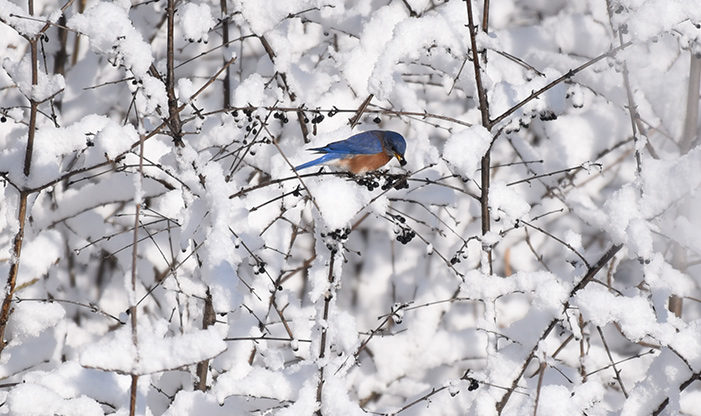Wisconsin winters are hard, even for the most prepared of birds. As winter bird survival becomes more difficult, many birds simply travel south. But for those who do not migrate, winter presents the continual challenge of finding food, warmth, and safety.
Food
Finding food becomes the primary concern for winter bird survival; without food, birds cannot stay warm. Many herbivores subsist off seed heads from last fall or tree buds growing for next spring. Summertime insect-eaters, like the Eastern Bluebird, may pivot to fruit. A replenishing food source like bird feeders are a welcome point of consistency, even when wild food is available. If the supply is steady, winter-long communities of birds and mammals will form in your backyard!
The healthiest communities support predatory birds. Birds of prey will remain in an area through the winter if the food is steady. Great Horned Owls can find resident mammals under the snow. Few things are more memorable in winter than the imprint of an owl in the snow!
Whatever their diet, winter birds often live on a razor’s edge: too heavy and flight may be impossible, too light and they can’t survive the night. Human sources of food help stabilize the entire food chain through the year’s hardest months.
Warmth
When birds are active, their bodies run at over 105°F. When temperatures are near zero in January and February, the air can be 100 degrees cooler than them! Unsurprisingly, different species have their own unique strategies for keeping warm.
Many winter birds can lower their body temperatures while they’re inactive. By entering a state called torpor, birds ranging from Red-tailed Hawks to Black-capped Chickadees conserve energy through the night. If you see these birds in the early morning, you’ll catch them warming up by shivering, then taking off to replenish their burned calories.
Another strategy for staying warm is to make a shelter. Most famous for this are woodpeckers, who you can hear hammering all winter long. But perhaps the most fascinating among shelter-making birds is the Ruffed Grouse. When the snow is deep enough, they dive and tunnel to create winter dens. Burrowing has its dangers, but it offers steady protection from the coldest of temperatures.
Safety
Predators have to eat too. For birds who aren’t on the top of the food chain, many like the American Crow aim for safety in numbers. While moving in a flock means more mouths to feed, it reduces each member’s individual risk and encourages social learning.
As crows move through the city, you can see a complex social strategy playing out. A ground team scours the area for food, while lookouts stay perched above. If there is an opportunity or danger, the ground team is alerted and the crows band together into a “murder” to aid in getting food. After a day of scavenging, smaller bands may roost together at night, forming “mega-murders” for extra safety. Because of their highly social nature, word gets around quickly. When one crow clashes with an offending coyote, finds a safe roosting site, or meets a human that stocks feeders with peanuts, that information is shared. Survival tips are remembered by the individual and the murder, even across generations!
Winter Bird Survival and You
As our feathered friends toil to find food, warmth, and safety through the winter, they often cross paths with humans. While most don’t need our help, there are plenty of ways to make their lives easier: Put bird feeders near cover, such as a good shrub, which can offer overnight shelter or temporary safety. Keep dead trees standing, as live and dead trees offer food and shelter. Also, be consistent with filling bird feeders, as a constant supply will enable return visitors.


